William Treacy runs a suckler-to-beef enterprise at Hackballs Cross, five miles from Dundalk in Co Louth.
Calving down 120 suckler cows annually, the farm is operated with just one labour unit.
To help curb the busy workload, William began to consider investing in a straw blower back in 2019.
Upon noting the benefits of such a machine, he started to do some homework on brand options. Three machines were considered – a Teagle, a Lucas and the McHale.
In the end, William opted for the McHale as O’Neill Tractors, a McHale agent, was his nearest dealership and he had previously bought machines from the company.
Time saving and safety benefit
William took delivery of a new McHale C460 silage feeder and straw blower in November 2019.
Now set to enter its third winter, William outlined that it has brought about huge time savings and helped to improve safety on the farm.
He explained: “I was always a fan of topping up the beds in the straw sheds little and often, usually every second day. I have seven straw-bedded sheds, including sheds for calving, creeping calves, housing weanlings and for finishing bulls.
“It was a very time-consuming task. And, to be honest, although I try to be careful, it was dangerous at times. Trying to break up a round bale of straw in with a cow just after calving or in a shed of finishing bulls is dangerous, especially if there’s a lot of dung built up underneath as it can be difficult to move out of the way.
“The huge workload and the safety element were the two reasons I decided to make the investment – and it did not disappoint. I’d estimate the machine has reduced the time I spend bedding cattle by 60%. As for the safety aspect, I now don’t ever have to leave the cab when bedding cattle.
“Even in the calving season, I always have a bale of straw left in the machine which is parked in the same shed. I find this is a great job because if a cow calves for example during the night, I just start the tractor and blow in some fresh straw – it takes no time and it’s safe.
“There is also the added benefit of a reduction in straw usage and I find the dung tends to be easier to spread. With the straw blower, you don’t get any lumps, it’s an even distribution.
“I’d say I’ve noticed a good 15% saving in straw. With the current price of straw, it all adds up. Also, because the straw is chopped, the dung seems to ferment that bit quicker and I find that it’s easier to spread on the land when the time comes.”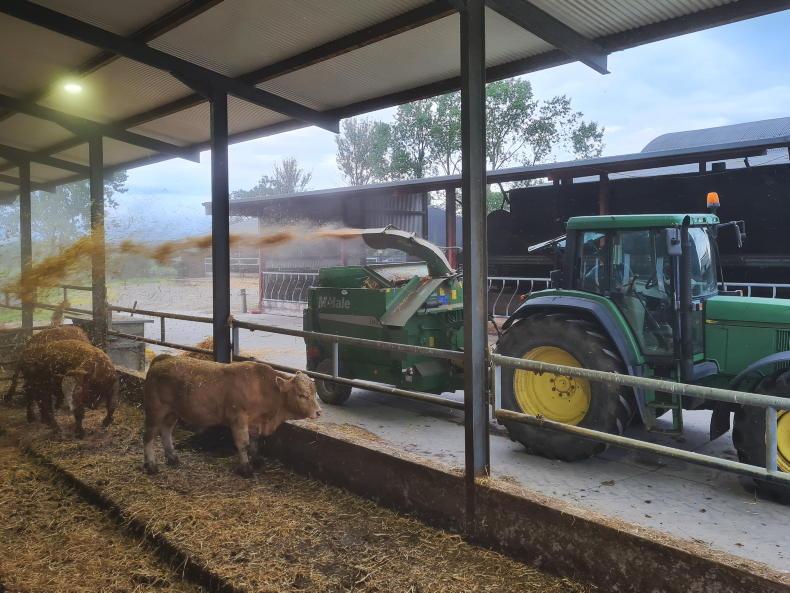
McHale claims the machine is capable of blowing straw up to 18m.
The workings of the machine
The C460 is the mid-model offering in the McHale range, which extends to four models (one linkage-mounted and three trailed).
Labelled as a straw blower and silage feeder, the machine can be self-loaded by pushing a bale up against a wall, or using a loader as William does. Once loaded and the net is removed, the hydraulically driven chain and slat conveyor floor is used to feed the bale towards the rotor. The floor speed can be adjusted accordingly from the control box, while the conveyor can also be reversed if necessary. 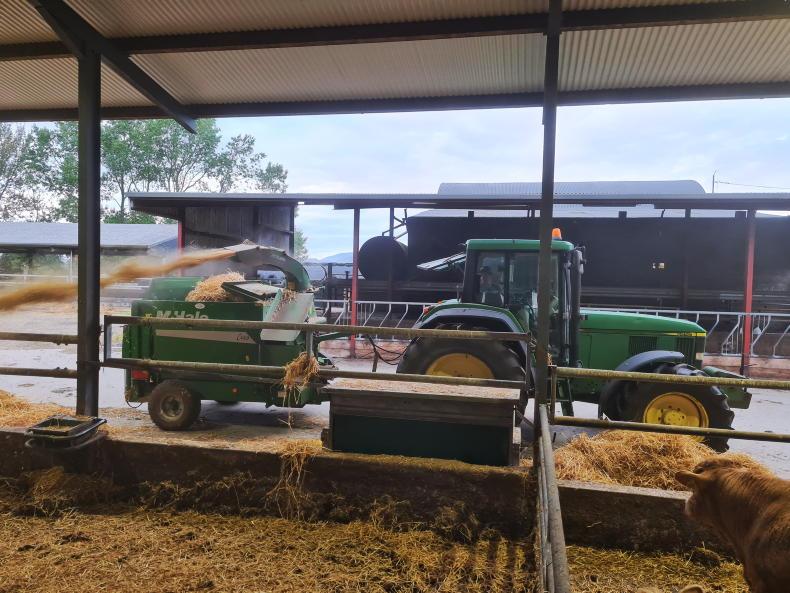
McHale uses a high-torque belt drive system which means the flywheel can be worked independently of the rotor.
The feed rotor is equipped with 56 blades which are mounted on seven discs. These blades are mounted at an angle on the discs and pass through a fixed comb to cut and feed the straw into the flywheel.
The rotor feeds the straw to the flywheel (1.57m diameter) which is fitted with six blowing paddles. McHale claims the machine is capable of blowing straw up to 18m. The deepest shed William uses the machine in is 45ft, but he noted the machine could blow a lot further if required.
The flywheel housing is positioned below the floor conveyor. This means that any loose material which falls into the flywheel housing is blown out. 
The feed rotor is equipped with 56 blades which are mounted on seven discs.

Now set to enter its third winter, William outlined that the machine has brought about huge time savings and helped to improve safety on the farm.
Hydraulically engaged feed rotor
McHale uses a high-torque belt drive system which allows for the feed rotor to be hydraulically engaged or disengaged. This means the flywheel can be worked independently of the rotor.
As a result, the flywheel can be at full rpm before the rotor starts to feed in any material. This reduces the possibility of blocking the machine on startup.
McHale also claims this system reduces the horsepower required to drive the machine. William uses a trusty John Deere 6810 which he runs at its ease in 540 economy at 1,800RPM, noting that it is very easy to run. 
The machine is fitted with a 300° three-stage chute.
The machine features a twin-speed independent gearbox with one setting for feeding silage and the other for blowing straw. A handle at the front of the machine allows the operator to adjust the gearbox from 280rpm for feeding silage or hay to 540rpm for using the machine to distribute straw for bedding.
Despite running the machine for the past two winters, William hasn’t yet used it to feed any silage. 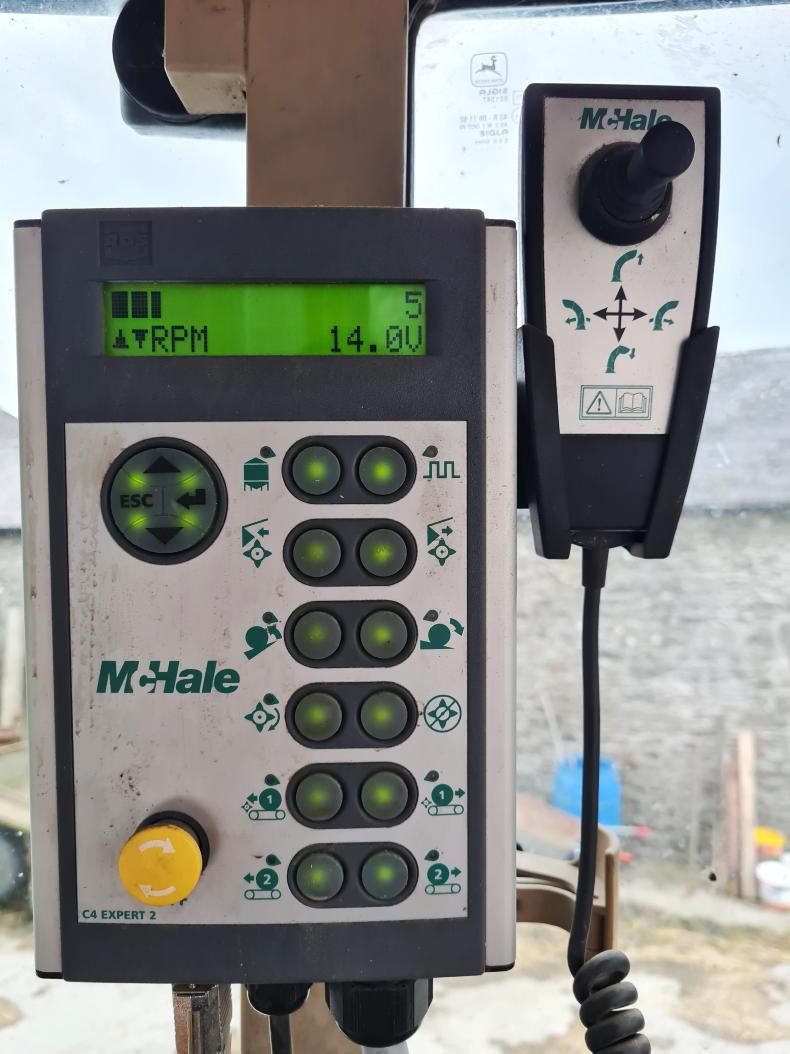
The C460 is controlled through an electronic control console that’s positioned in the tractor cab.
The C460 is controlled through an electronic control console that’s positioned in the tractor cab.
“I like the control console; it is very easy to use. All the machine functions can be operated from the console without having to leave the tractor seat,” added William.
The unit also features an external loading control. This is a control function fitted at the rear left corner of the machine. It allows for the conveyor floor and the tailgate to be operated when removing the net and loading a bale.
“I think this is a good feature. To make sure the operator’s two hands are used, a safety button on the side of the control box has to be held while pressing the loading functions. Despite this, sometimes I wonder should it be positioned a little bit further forward, just to keep the operator that bit further away from the loading door,” noted William. 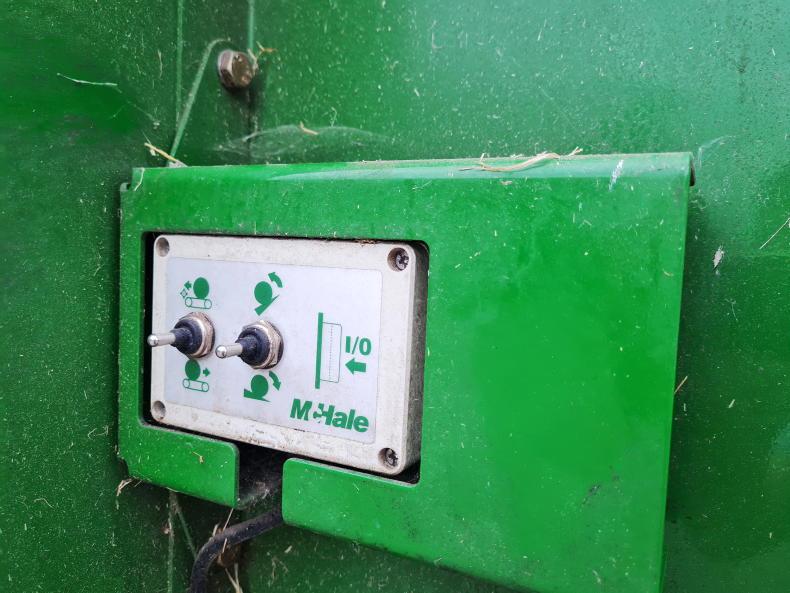
The unit also features an external loading control.
The machine is fitted with a 300° three-stage chute. As mentioned, McHale says the three-stage design allows straw to be blown 18m on the right hand side up to 13m to the left of the machine. The chute is rotated using a joystick on the control box. 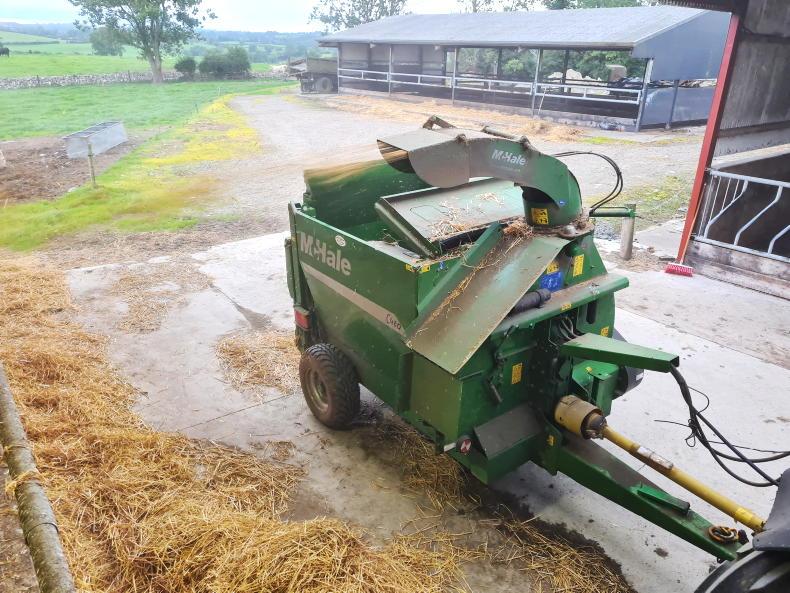
The verdict
“I’m very happy with my decision to invest in a straw blower. I could never go back physically shaking out straw.
“It has turned a painstaking task into a job that I now like doing. I would typically use around 400 bales of straw each year.
“In fairness, the machine seems well built and is compact. After the two seasons I can see little or no wear anywhere, which is probably down to the fact I only use it for straw and not to feed silage. The wide-angle shaft is a must. I use the machine to blow straw into some tricky sheds where I have the machine running at an angle to the tractor.
“I have two seasons completed with the C460 and so far it has been bulletproof, it hasn’t given a day’s trouble.
“The big benefits have been the reduction in workload, the much improved safety element and the reduction in straw usage,” outlined William.
? Likes
Easy to use.Easy to put on and take off the tractor.Well built; little to no wear.? Dislikes
Should the rear control panel be relocated?C460 spec:
Model: C460.Weight: 2,220kg.Horsepower requirement: 68hp.Hydraulic requirement: 35l/min.Tractor hydraulics required: One feed and one return.Chute: Three-stage 300° rotation.Max discharge distance (to right): 18m.Knives: 56.Control: electrical with joystick chute control.Tyres: 10.0/ 75 – 15.3 (optional; 340/55-16).Price: €17,500 plus VAT.
William Treacy runs a suckler-to-beef enterprise at Hackballs Cross, five miles from Dundalk in Co Louth.
Calving down 120 suckler cows annually, the farm is operated with just one labour unit.
To help curb the busy workload, William began to consider investing in a straw blower back in 2019.
Upon noting the benefits of such a machine, he started to do some homework on brand options. Three machines were considered – a Teagle, a Lucas and the McHale.
In the end, William opted for the McHale as O’Neill Tractors, a McHale agent, was his nearest dealership and he had previously bought machines from the company.
Time saving and safety benefit
William took delivery of a new McHale C460 silage feeder and straw blower in November 2019.
Now set to enter its third winter, William outlined that it has brought about huge time savings and helped to improve safety on the farm.
He explained: “I was always a fan of topping up the beds in the straw sheds little and often, usually every second day. I have seven straw-bedded sheds, including sheds for calving, creeping calves, housing weanlings and for finishing bulls.
“It was a very time-consuming task. And, to be honest, although I try to be careful, it was dangerous at times. Trying to break up a round bale of straw in with a cow just after calving or in a shed of finishing bulls is dangerous, especially if there’s a lot of dung built up underneath as it can be difficult to move out of the way.
“The huge workload and the safety element were the two reasons I decided to make the investment – and it did not disappoint. I’d estimate the machine has reduced the time I spend bedding cattle by 60%. As for the safety aspect, I now don’t ever have to leave the cab when bedding cattle.
“Even in the calving season, I always have a bale of straw left in the machine which is parked in the same shed. I find this is a great job because if a cow calves for example during the night, I just start the tractor and blow in some fresh straw – it takes no time and it’s safe.
“There is also the added benefit of a reduction in straw usage and I find the dung tends to be easier to spread. With the straw blower, you don’t get any lumps, it’s an even distribution.
“I’d say I’ve noticed a good 15% saving in straw. With the current price of straw, it all adds up. Also, because the straw is chopped, the dung seems to ferment that bit quicker and I find that it’s easier to spread on the land when the time comes.”
McHale claims the machine is capable of blowing straw up to 18m.
The workings of the machine
The C460 is the mid-model offering in the McHale range, which extends to four models (one linkage-mounted and three trailed).
Labelled as a straw blower and silage feeder, the machine can be self-loaded by pushing a bale up against a wall, or using a loader as William does. Once loaded and the net is removed, the hydraulically driven chain and slat conveyor floor is used to feed the bale towards the rotor. The floor speed can be adjusted accordingly from the control box, while the conveyor can also be reversed if necessary. 
McHale uses a high-torque belt drive system which means the flywheel can be worked independently of the rotor.
The feed rotor is equipped with 56 blades which are mounted on seven discs. These blades are mounted at an angle on the discs and pass through a fixed comb to cut and feed the straw into the flywheel.
The rotor feeds the straw to the flywheel (1.57m diameter) which is fitted with six blowing paddles. McHale claims the machine is capable of blowing straw up to 18m. The deepest shed William uses the machine in is 45ft, but he noted the machine could blow a lot further if required.
The flywheel housing is positioned below the floor conveyor. This means that any loose material which falls into the flywheel housing is blown out. 
The feed rotor is equipped with 56 blades which are mounted on seven discs.

Now set to enter its third winter, William outlined that the machine has brought about huge time savings and helped to improve safety on the farm.
Hydraulically engaged feed rotor
McHale uses a high-torque belt drive system which allows for the feed rotor to be hydraulically engaged or disengaged. This means the flywheel can be worked independently of the rotor.
As a result, the flywheel can be at full rpm before the rotor starts to feed in any material. This reduces the possibility of blocking the machine on startup.
McHale also claims this system reduces the horsepower required to drive the machine. William uses a trusty John Deere 6810 which he runs at its ease in 540 economy at 1,800RPM, noting that it is very easy to run. 
The machine is fitted with a 300° three-stage chute.
The machine features a twin-speed independent gearbox with one setting for feeding silage and the other for blowing straw. A handle at the front of the machine allows the operator to adjust the gearbox from 280rpm for feeding silage or hay to 540rpm for using the machine to distribute straw for bedding.
Despite running the machine for the past two winters, William hasn’t yet used it to feed any silage. 
The C460 is controlled through an electronic control console that’s positioned in the tractor cab.
The C460 is controlled through an electronic control console that’s positioned in the tractor cab.
“I like the control console; it is very easy to use. All the machine functions can be operated from the console without having to leave the tractor seat,” added William.
The unit also features an external loading control. This is a control function fitted at the rear left corner of the machine. It allows for the conveyor floor and the tailgate to be operated when removing the net and loading a bale.
“I think this is a good feature. To make sure the operator’s two hands are used, a safety button on the side of the control box has to be held while pressing the loading functions. Despite this, sometimes I wonder should it be positioned a little bit further forward, just to keep the operator that bit further away from the loading door,” noted William. 
The unit also features an external loading control.
The machine is fitted with a 300° three-stage chute. As mentioned, McHale says the three-stage design allows straw to be blown 18m on the right hand side up to 13m to the left of the machine. The chute is rotated using a joystick on the control box. 
The verdict
“I’m very happy with my decision to invest in a straw blower. I could never go back physically shaking out straw.
“It has turned a painstaking task into a job that I now like doing. I would typically use around 400 bales of straw each year.
“In fairness, the machine seems well built and is compact. After the two seasons I can see little or no wear anywhere, which is probably down to the fact I only use it for straw and not to feed silage. The wide-angle shaft is a must. I use the machine to blow straw into some tricky sheds where I have the machine running at an angle to the tractor.
“I have two seasons completed with the C460 and so far it has been bulletproof, it hasn’t given a day’s trouble.
“The big benefits have been the reduction in workload, the much improved safety element and the reduction in straw usage,” outlined William.
? Likes
Easy to use.Easy to put on and take off the tractor.Well built; little to no wear.? Dislikes
Should the rear control panel be relocated?C460 spec:
Model: C460.Weight: 2,220kg.Horsepower requirement: 68hp.Hydraulic requirement: 35l/min.Tractor hydraulics required: One feed and one return.Chute: Three-stage 300° rotation.Max discharge distance (to right): 18m.Knives: 56.Control: electrical with joystick chute control.Tyres: 10.0/ 75 – 15.3 (optional; 340/55-16).Price: €17,500 plus VAT.


































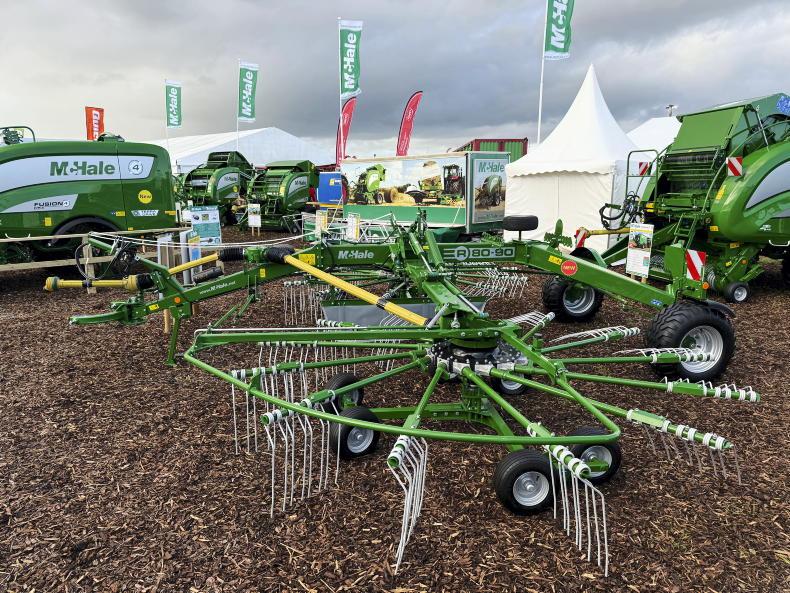

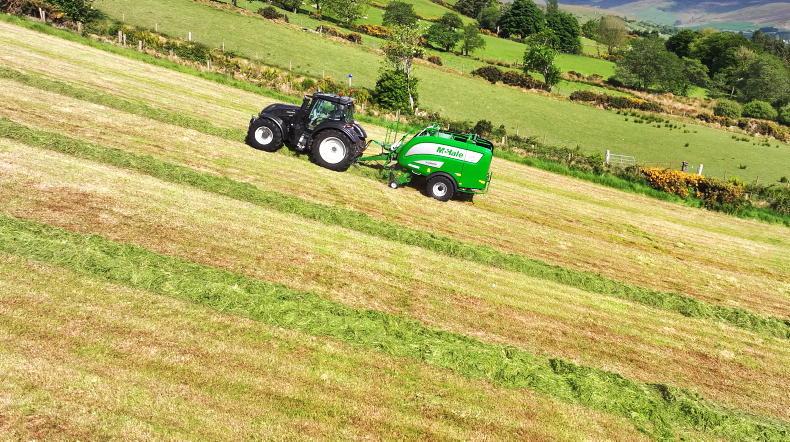
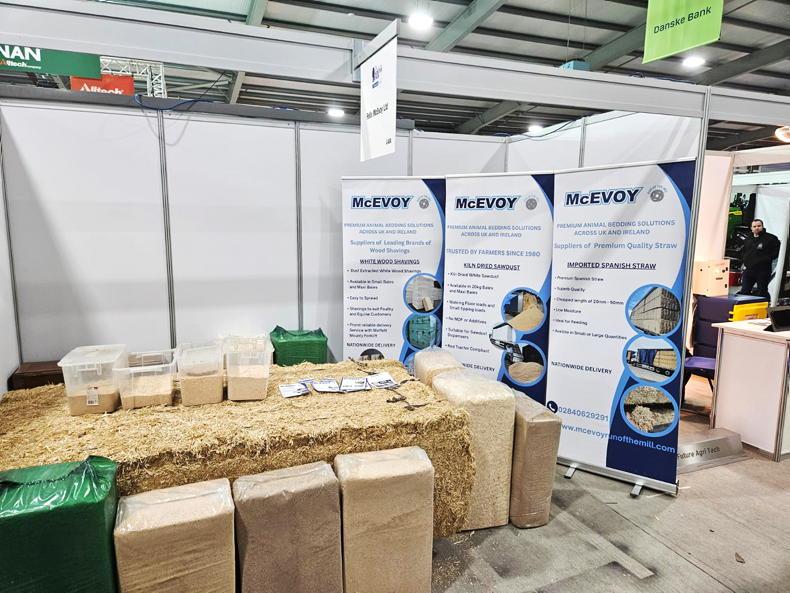

SHARING OPTIONS